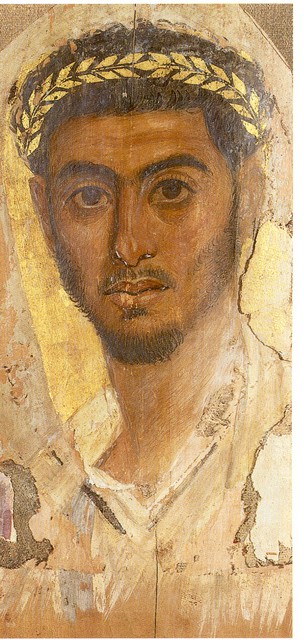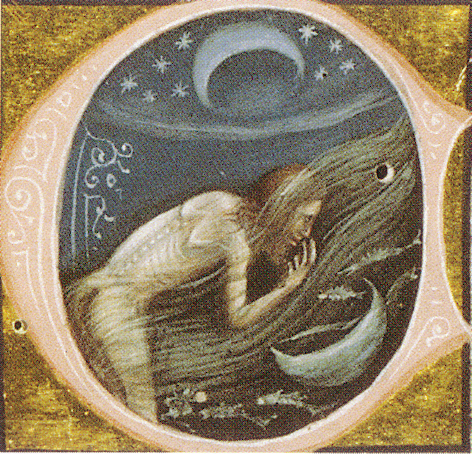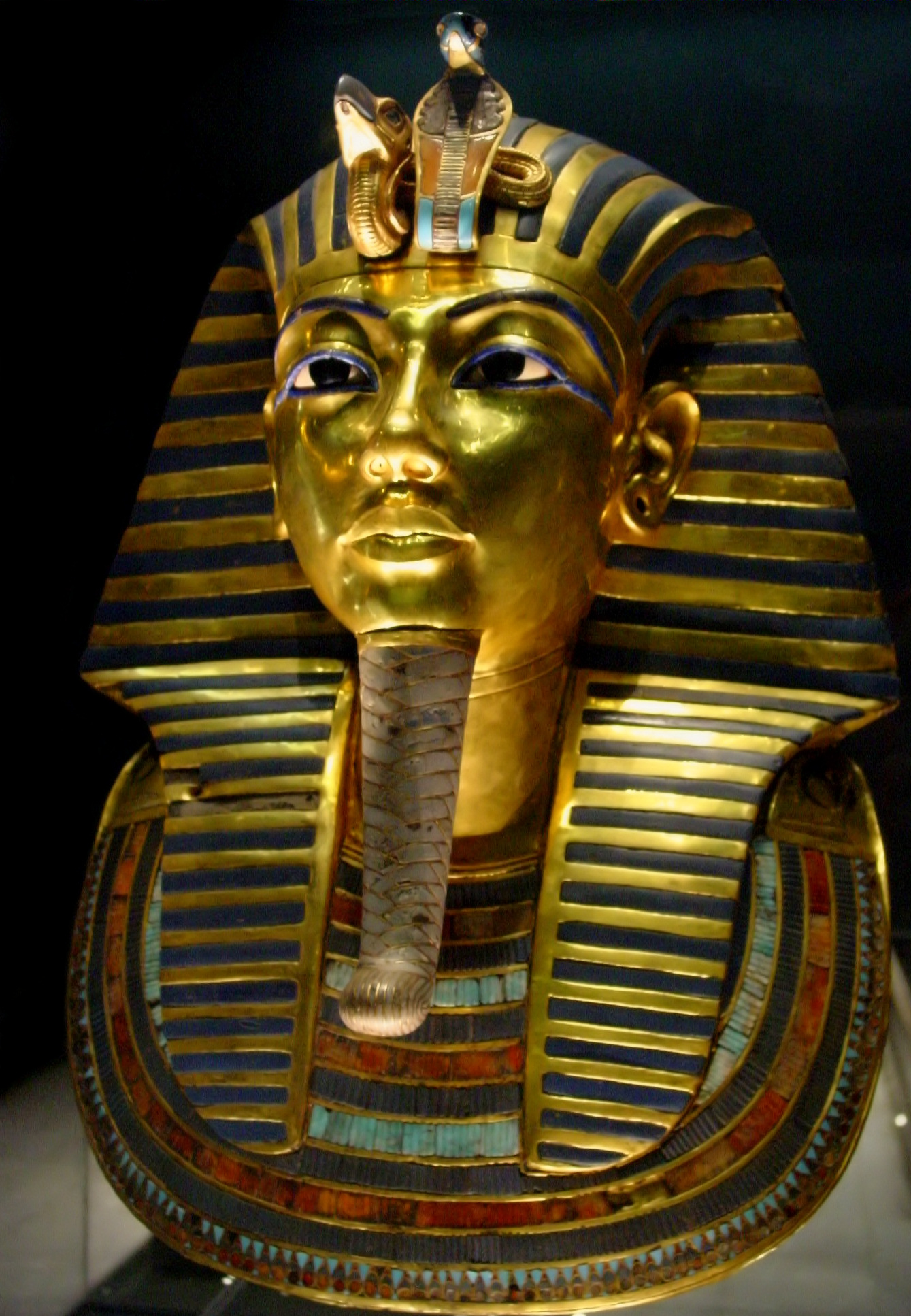|
Crown Of Justification
In ancient Egyptian religion, the crown of justification ''(mꜣḥ n mꜣꜥ ḫrw'') was a wreath or fillet worn by the deceased to represent victory over death in the afterlife. Its symbolism is based on Chapter 19 of the '' Book of the Dead,'' in which the wearer is said to be "justified" by a triumph over death just as the god Osiris eventually rose above his enemies. A ritual text was recited as the dead person was crowned. The crown of justification might be made of laurel, palm, feathers, papyrus, or precious metals. It was syncretized with the solar crown of the sun god Re, and might be made of gold to mimic the properties of the sun. Among the collections of the Museum of Fine Arts, Boston, is an intricately woven papyrus wreath with bronze insets to reflect light. In the Roman era, initiates into the mysteries of Isis might wear a wreath of palm leaves to suggest the rays of the sun. In the Ptolemaic and Roman Imperial periods, religious art in temples shows the ... [...More Info...] [...Related Items...] OR: [Wikipedia] [Google] [Baidu] |
The Golden Ass
The ''Metamorphoses'' of Apuleius, which Augustine of Hippo referred to as ''The Golden Ass'' (''Asinus aureus''), is the only ancient Roman novel in Latin to survive in its entirety. The protagonist of the novel is Lucius. At the end of the novel, he is revealed to be from Madaurus, the hometown of Apuleius himself. The plot revolves around the protagonist's curiosity (''curiositas'') and insatiable desire to see and practice magic. While trying to perform a spell to transform into a bird, he is accidentally transformed into an ass. This leads to a long journey, literal and metaphorical, filled with inset tales. He finally finds salvation through the intervention of the goddess Isis, whose cult he joins. Origin The date of composition of the ''Metamorphoses'' is uncertain. It has variously been considered by scholars as a youthful work preceding Apuleius' ''Apology'' of 158–159, or as the climax of his literary career, and perhaps as late as the 170s or 180s. Apuleius adap ... [...More Info...] [...Related Items...] OR: [Wikipedia] [Google] [Baidu] |
Crown Of Immortality
The Crown of Immortality is a literary and religious metaphor traditionally represented in art first as a laurel wreath and later as a symbolic circle of stars (often a crown, tiara, halo or aureola). The Crown appears in a number of Baroque iconographic and allegoric works of art to indicate the wearer's immortality. Wreath crowns In ancient Egypt, the crown of justification was a wreath placed on the deceased to represent victory over death in the afterlife, in emulation of the resurrecting god Osiris. It was made of various materials including laurel, palm, feathers, papyrus, roses, or precious metals, with numerous examples represented on the Fayum mummy portraits of the Roman Imperial period. In ancient Greece, a wreath of laurel or olive was awarded to victorious athletes and later poets. Among the Romans, generals celebrating a formal triumph wore a laurel wreath, an honor that during the Empire was restricted to the Imperial family. The placing of the wreath was oft ... [...More Info...] [...Related Items...] OR: [Wikipedia] [Google] [Baidu] |
Crowns Of Egypt
The Egyptian civilization used a number of different crowns throughout its existence. Some were used to show authority, while others were used for religious ceremonies. Each crown was worn by different pharaohs or deities, and each crown had its own significance and symbolic meaning. The crowns include the Atef, the Deshret, the Hedjet, the Khepresh, the Pschent, and the Hemhem. List of crowns of Egypt Atef Atef, the crown of Osiris, is a combination of Upper Egypt’s white crown, the hedjet, and ostrich feathers on either side. It also often has a golden disc at its tip. The ostrich feathers, similar to those representing ma’at, symbolize truth, justice, morality, and balance. They represent the cult center of Orisis as well, which is located in Abydos. The atef is typically worn atop a pair of ram or bull horns as a circlet. The atef crown is seen as far back as the 5th dynasty. According to Egyptian beliefs, this crown represents Osiris as the god of fertility, ruler ... [...More Info...] [...Related Items...] OR: [Wikipedia] [Google] [Baidu] |
Interpretatio Graeca
''Interpretatio graeca'' (Latin, "Greek translation") or "interpretation by means of Greek odels is a discourse used to interpret or attempt to understand the mythology and religion of other cultures; a comparative methodology using ancient Greek religious concepts and practices, deities, and myths, equivalencies, and shared characteristics. The phrase may describe Greek efforts to explain others' beliefs and myths, as when Herodotus describes Egyptian religion in terms of perceived Greek analogues, or when Dionysius of Halicarnassus and Plutarch document Roman cults, temples, and practices under the names of equivalent Greek deities. ''Interpretatio graeca'' may also describe non-Greeks' interpretation of their own belief systems by comparison or assimilation with Greek models, as when Romans adapt Greek myths and iconography under the names of their own gods. ''Interpretatio romana'' is comparative discourse in reference to ancient Roman religion and myth, as in the form ... [...More Info...] [...Related Items...] OR: [Wikipedia] [Google] [Baidu] |
Rosalia (festival)
In the Roman Empire, Rosalia or Rosaria was a festival of roses celebrated on various dates, primarily in May, but scattered through mid-July. The observance is sometimes called a ''rosatio'' ("rose-adornment") or the ''dies rosationis'', "day of rose-adornment," and could be celebrated also with violets ''(violatio'', an adorning with violets, also ''dies violae'' or ''dies violationis'', "day of the "). As a commemoration of the dead, the ''rosatio'' developed from the custom of placing flowers at burial sites. It was among the extensive private religious practices by means of which the Romans cared for their dead, reflecting the value placed on tradition ''( mos maiorum'', "the way of the ancestors"), family lineage, and memorials ranging from simple inscriptions to grand public works. Several dates on the Roman calendar were set aside as public holidays or memorial days devoted to the dead. As a religious expression, a ''rosatio'' might also be offered to the cult statue of ... [...More Info...] [...Related Items...] OR: [Wikipedia] [Google] [Baidu] |
Wedjat
Wadjet (; egy, wꜢḏyt "Green One"), known to the Greek world as Uto (; grc-koi, Οὐτώ) or Buto (; ) among other renderings including Wedjat, Uadjet, and Udjo, was originally the ancient local goddess of the city of Dep. It became part of the city that the Egyptians named Per-Wadjet ("House of Wadjet") and the Greeks called Buto (now Desouk), which was an important site in prehistoric Egypt and the cultural developments of the Paleolithic. There was also a Per-Wadjet in Upper Egypt. Wadjet was said to be the matron and protector of Lower Egypt, and upon unification with Upper Egypt, the joint protector and patron of all of Egypt. The image of Wadjet with the sun disk is called the uraeus, and it was the emblem on the crown of the rulers of Lower Egypt. She was also the protector of kings and of women in childbirth. Wadjet was said to be the nurse of the infant god Horus. With the help of his mother Isis, they protected Horus from his treacherous uncle, Set, when they t ... [...More Info...] [...Related Items...] OR: [Wikipedia] [Google] [Baidu] |
Uraeus
The Uraeus (), or Ouraeus (Ancient Greek: , ; Egyptian: ', "rearing cobra"), ''(plural: Uraei)'' is the stylized, upright form of an Egyptian cobra, used as a symbol of sovereignty, royalty, deity and divine authority in ancient Egypt. Symbolism The Uraeus is a symbol for the goddess Wadjet.Egyptian-Gods She was one of the earliest Egyptian deities and was often depicted as a cobra, as she is the serpent goddess. The center of her cult was in Per-Wadjet, later called Buto by the Greeks. She became the patroness of the Nile Delta and the protector of all of Lower Egypt. The pharaohs wore the uraeus as a head ornament: either with the body of Wadjet atop the head, or as a crown encircling the head; this indicated Wadjet's protection and reinforced the pharaoh's claim over the land. In whatever manner that the Uraeus was displayed upon the pharaoh's head, it was, in effect, part of the pharaoh's crown. The pharaoh was recognized only by wearing the Uraeus, which conveye ... [...More Info...] [...Related Items...] OR: [Wikipedia] [Google] [Baidu] |
Circlet
A circlet is a piece of headwear that is similar to a diadem or a corolla. The word 'circlet' is also used to refer to the base of a crown or a coronet, with or without a cap. Diadem and circlet are often used interchangeably, and 'open crowns' with no arches (as opposed to 'closed crowns') have also been referred to as circlets. In Greek this is known as ''stephanos'', and in Latin as ''corona aperta'', although ''stephanos'' is associated more with laurel wreaths and the crown of thorns said to have been placed on the head of Jesus. Heraldic circlet In heraldry, a circlet of an order of knighthood may be placed around the shield of the bearer to signify membership of a particular order. In British heraldry, this pertains to the grades of Commander and above (i.e. Knight Commander and Knight Grand Cross). See also * Achievement (heraldry) *Tiara A tiara (from la, tiara, from grc, τιάρα) is a jeweled head ornament. Its origins date back to ancient Greece and Rome. I ... [...More Info...] [...Related Items...] OR: [Wikipedia] [Google] [Baidu] |
Ancient Egyptian Deities
Ancient Egyptian deities are the God (male deity), gods and goddesses worshipped in ancient Egypt. The beliefs and rituals surrounding these gods formed the core of ancient Egyptian religion, which emerged sometime in prehistoric Egypt, prehistory. Deities represented natural phenomenon, natural forces and phenomena, and the Egyptians supported and appeased them through sacrifice, offerings and rituals so that these forces would continue to function according to ''maat'', or divine order. After the founding of the Egyptian state around 3100 BC, the authority to perform these tasks was controlled by the pharaoh, who claimed to be the gods' representative and managed the Egyptian temple, temples where the rituals were carried out. The gods' complex characteristics were expressed in Egyptian mythology, myths and in intricate relationships between deities: family ties, loose groups and hierarchies, and combinations of separate gods into one. Deities' diverse appearances in art ... [...More Info...] [...Related Items...] OR: [Wikipedia] [Google] [Baidu] |
Horus
Horus or Heru, Hor, Har in Ancient Egyptian, is one of the most significant ancient Egyptian deities who served many functions, most notably as god of kingship and the sky. He was worshipped from at least the late prehistoric Egypt until the Ptolemaic Kingdom and Roman Egypt. Different forms of Horus are recorded in history, and these are treated as distinct gods by Egyptologists."The Oxford Guide: Essential Guide to Egyptian Mythology", Edited by Donald B. Redford, Horus: by Edmund S. Meltzer, pp. 164–168, Berkley, 2003, . These various forms may be different manifestations of the same multi-layered deity in which certain attributes or syncretic relationships are emphasized, not necessarily in opposition but complementary to one another, consistent with how the Ancient Egyptians viewed the multiple facets of reality. He was most often depicted as a falcon, most likely a lanner falcon or peregrine falcon, or as a man with a falcon head. The earliest recorded form of Ho ... [...More Info...] [...Related Items...] OR: [Wikipedia] [Google] [Baidu] |
Egyptian Temple
Egyptian temples were built for the official worship of the gods and in commemoration of the pharaohs in ancient Egypt and regions under Egyptian control. Temples were seen as houses for the gods or kings to whom they were dedicated. Within them, the Egyptians performed a variety of rituals, the central functions of Egyptian religion: giving offerings to the gods, reenacting their mythological interactions through festivals, and warding off the forces of chaos. These rituals were seen as necessary for the gods to continue to uphold ''maat'', the divine order of the universe. Housing and caring for the gods were the obligations of pharaohs, who therefore dedicated prodigious resources to temple construction and maintenance. Out of necessity, pharaohs delegated most of their ritual duties to a host of priests, but most of the populace was excluded from direct participation in ceremonies and forbidden to enter a temple's most sacred areas. Nevertheless, a temple was an important r ... [...More Info...] [...Related Items...] OR: [Wikipedia] [Google] [Baidu] |







